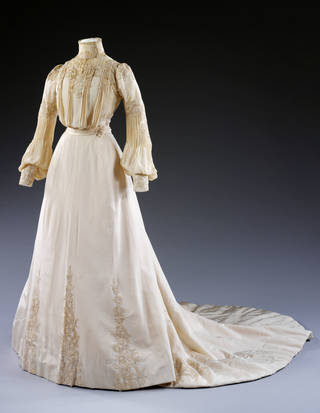Together, our collection of wedding dress expresses social and sartorial change over four centuries. As individual garments, they reveal fascinating personal insights into the lifestyles and tastes of their original owners.
Every dress in the collection has its own story, but the four described here are particularly distinct. Arguably the most important dresses of their wearer's lives, they make bold statements about identity and personality: belonging to four very different women, living four very different lives.
The oldest of these dresses was worn by Mary Dalton Norcliffe in 1807. The sash-tied empire line dress might look familiar if you've ever watched a Jane Austen period drama. Late 18th- and early-19th century England was preoccupied with neoclassicism. Much like modern-day fans of 1950s vintage clothing, the Georgians romanticised an earlier time. Mary's dress, influenced by the styles of Ancient Rome and Greece, would have been a very fashionable choice. It also seems appropriate that Mary, only 17 when she married, chose a style which had its origins in children's and early teen wear – the sash-tied dress evokes the simple muslin garments worn by young girls, before they progressed to stiff bodied gowns.


The second dress, a fine example of Edwardian elegance, belonged to Edith Hope-Murray. Edith married Reverend Thomas Senior in south London in 1902. She was a clergyman's daughter, who, through marriage, became a clergyman's wife. These social distinctions meant she had a high standing in the affluent middle-class suburb of Upper Norwood, where she and her family lived.

The dress, made by skilled local dressmakers Houghton & Dalton, consists of a separate cream silk bodice and skirt, which swells into a stately, heavy-lined train. The high neck and long, darted sleeves convey a sense of dignity and sophistication, utterly befitting of Edith's conservative standards and social rank.

Thirty years later, acclaimed society beauty and gossip columnists' favourite, Margaret Whigham (later, the Duchess of Argyll), wore a stunning Norman Hartnell gown for her 1933 wedding to Charles Sweeny at Brompton Oratory, London.

A frenzy of public interest in the wedding was spurred on by daily mentions of Margaret in the newspapers. On the day, the couple's exit from the Brompton Oratory was filmed by Pathé, and shown as a newsreel entitled Brilliant Society Wedding. So large was the crowd of spectators, Hyde Park traffic was brought to a halt. For an event that was so much in the public eye, a spectacular dress was needed. Luckily, leading British fashion designer Norman Hartnell – who would later design both the wedding dress and Coronation gown of Queen Elizabeth II – did not disappoint.
Designed specifically for making an entrance, Margaret's dress has an 18-foot train framed in ruched silk tulle. It is scattered with pearl-embroidered stars, some of which are transparent, placed both on the skirt and at reasonably risqué points on the dress's bodice. Opulent and lavish, this dress, and the extreme public interest it inspired, secured its wearer's position as a signifier of sumptuous sexuality and style.

In 1957, Laurel Heath wore a very different Norman Hartnell creation for her wedding to Gerald Robinson. Following wartime restraint, the late 1950s were a time of glamour and elegance. Fortunately for Laurel, she had a mother-in-law who appreciated style and had all of her clothes made especially for her by Hartnell. Lucky Laurel received a personal taste of Hartnell's superior workmanship and eye for detail when her mother-in-law gave her a Hartnell dress to wear on her big day.

As this was to be Laurel's second marriage – her first husband had sadly died the year before – she wanted to avoid the floor-length fuss of a first-time bride. Instead, Hartnell made her a dress that rested at mid-calf, its skirt rounded and full in the manner of a ballerina's. Such cuts were hugely fashionable at the time, popularised by the likes of Audrey Hepburn in Funny Face (1957), which came out the same year as Laurel married Gerald.

Each of these dresses demonstrates how a bride's fashion choices reflect elements of her personality and status as she transitions to married life. Historically, they provide an illuminating glimpse into the evolution of female identity. Today, women have significantly more social freedom than their forebears, opening up new possibilities for the future of wedding dress design.


